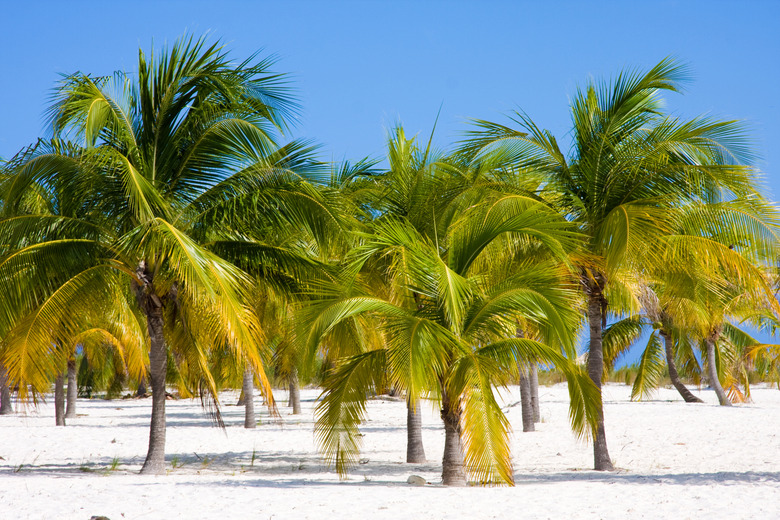Why Do Palm Fronds Turn Yellow?
We may receive a commission on purchases made from links.
When palm fronds turn yellow, it can be alarming, but there are a variety of causes of yellowing, some of which are easy to correct. Palms are a distinctive type of plant in the family Arecaceae that include more than 2,000 types. Some grow in tropical and semitropical climates, but there are also selections that are cold hardy that can grow in marginal areas. The leaves are fan or feather-like arranged in a spiral at the top of the tree. Palms are generally easy to grow, but they do need some special care. Yellowing of fronds can be a problem caused by a number of factors.
Tip
Palm fronds turn yellow for a number of reasons, including poor nutrition, pest infestations and fungal diseases.
Why Palm Fronds Turn Yellow
Why Palm Fronds Turn Yellow
Several different factors can make palm fronds turn yellow. There may be deficiencies in the soil or an unfavorable pH that keep the root systems from utilizing nutrients. There may not be sufficient nutrition in the soil or, conversely, there may be excessive quantities of nutrients. Some of the pests that commonly attack palm trees may be present, damaging cell structures. Fungal pathogens can also be a problem for palm trees.
Yellowing From Poor Nutrition
Yellowing From Poor Nutrition
Nitrogen deficiency can cause yellowing (chlorosis) of the older leaves on palms. Controlled-release fertilizer of 18-6-12 (N-P-K) to replace nitrogen is recommended to correct the imbalance.
Iron deficiency, caused by a lack of soil aeration and by planting palms too deeply, can also cause yellow leaves. This yellowing tends to occur most often on younger leaves. Adding chelated iron rather than iron sulphate to amend the soil can help the problem to some extent, but the underlying problem in cultivation must be corrected.
A lack of magnesium can also cause yellowing of both older and younger leaves, as well as darkening (necrosis) of leaf tissue. It can be difficult to treat. Fertilizer with magnesium micronutrient added, such as 8-2-12+4Mg with additional dolomite is suggested to correct the problem.
Pest and Fungal Infestations
Pest and Fungal Infestations
Fungi like bud rot, fusarium wilt and ganoderma butt rot can infect palms, weakening the trees and causing discoloration of leaves. Pests like thrips, giant palm borers, palm budworms and palmetto weevils can also attack palms, causing both leaf and trunk damage. Consult your local agricultural extension for the most effective ways to control these pests on your specific palm species.
Lethal Yellowing Disease
Lethal Yellowing Disease
Lethal yellowing is a relatively new disease that has attacked palm trees since the 1960s, primarily in areas that grow coconuts. The disease can be confused with other yellowing conditions of palms but is distinguished by the dropping of the coconuts, the blackening of flower stalks, subsequent yellowing of the palms, and collapse of the newly emerged spear leaf. The tree will die within three to six months. Injection of oxytetracycline is done to save trees considered vital.
Pruning of Palm Leaves
Pruning of Palm Leaves
Palm leaves go through a natural growth process that will cause the leaves to go from green to yellow to brown. While you can prune the dying fronds with a pruning saw, it's not necessary to remove the leaves when they are yellow. You disturb the tree's natural way of conserving nutrients by removing them too soon. When yellowing occurs on new leaves, however, it indicates a nutritional problem.
